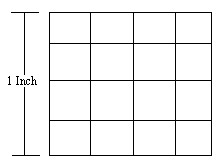Today I thought I'd talk about the different size classifications of aggregates. There are infinite size distributions of aggregates. These sizes can either be referred to in metric or English units. At one time Caltrans tried to switch over to metric units but have since switched back to English units. However, you will probably see specifications and results in both different sizing types. The following is a simple conversion chart for your use:
English | Metric |
1" | 25mm |
3/4" | 19mm |
1/2" | 12.5mm |
3/8" | 9.5mm |
#4 | 4.75mm |
#8 | 2.36mm |
#16 | 1.18mm |
#30 | 0.6mm |
#50 | 0.3mm |
#100 | 0.15mm |
#200 | 75um |
I'm sure you're wondering why the English units have numbered sieves. These numbers correspond to how many of that size sieve squares can be lined up to make a 1" line. So a #4 sieve screen uses 4 squares to make up a 1" line. You can see what I mean in the picture below.
Aggregate materials are generally broken up into two classifications of size: fine and coarse aggregate. Coarse aggregates are typically sizes larger than the #4 sieve. Fine aggregates are typically sizes smaller than the #4 sieve. What people refer to as "dust" is typically aggregate smaller than the #200 sieve.
Simple enough right? Any questions?


No comments:
Post a Comment